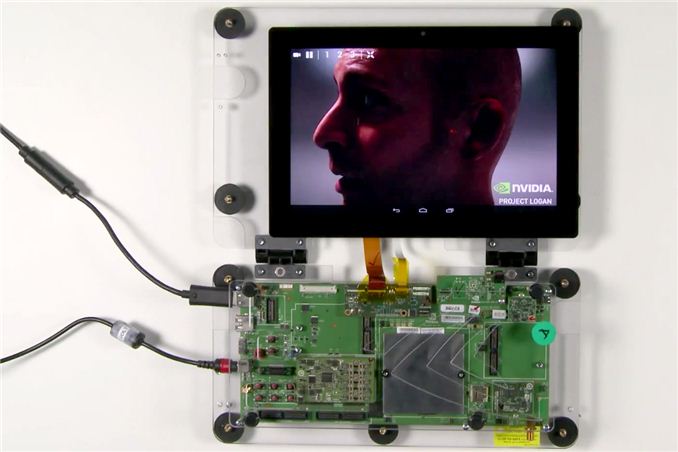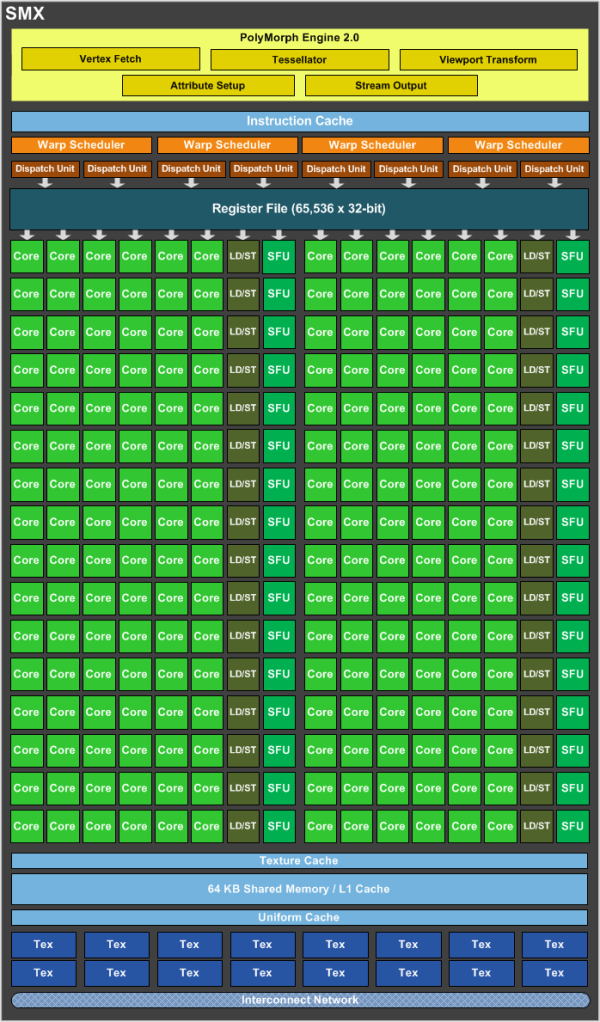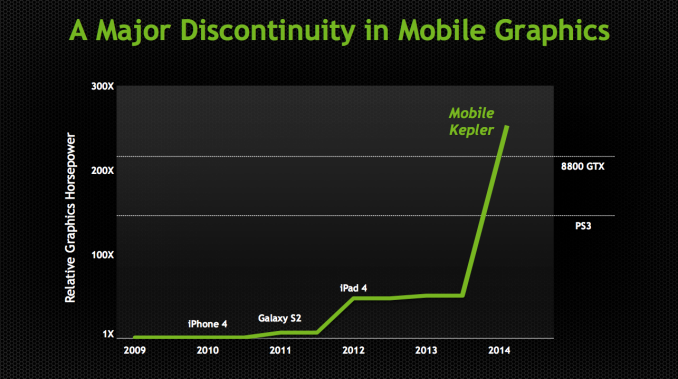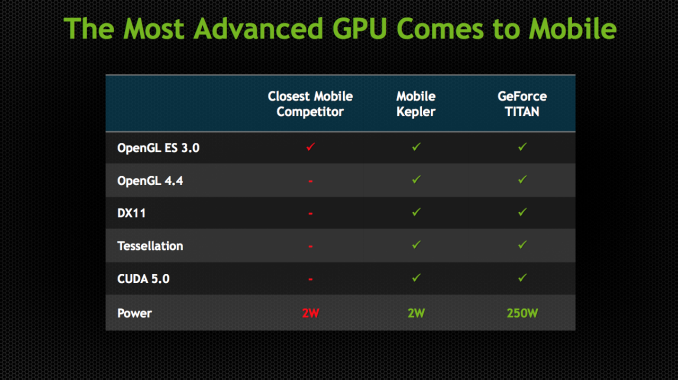NVIDIA Demonstrates Logan SoC: < 1W Kepler, Shipping in 1H 2014, More Energy Efficient than A6X?
by Anand Lal Shimpi on July 24, 2013 9:00 AM EST
Ever since its arrival in the ultra mobile space, NVIDIA hasn't really flexed its GPU muscle. The Tegra GPUs we've seen thus far have been ok at best, and in serious need of improvement at worst. NVIDIA often blamed an immature OEM ecosystem unwilling to pay for the sort of large die SoCs necessary in order to bring a high-performance GPU to market. Thankfully, that's all changing. Earlier this year NVIDIA laid out its mobile SoC roadmap through 2015, including the 2014 release of Project Logan - the first NVIDIA ultra mobile SoC to feature a Kepler GPU. Yesterday in a private event at Siggraph, NVIDIA demonstrated functional Logan silicon for the very first time.
NVIDIA got Logan silicon back from the fabs around 3 weeks ago, making it almost certain that we're dealing with some form of 28nm silicon here and not early 20nm samples.
NVIDIA isn't talking about CPU cores, but it's safe to assume that Logan will be another 4+1 arrangement of cores - likely still based on ARM's Cortex A15 IP (but perhaps a newer revision of the core). On the GPU front, NVIDIA confirmed our earlier speculation that Logan includes a single Kepler SMX:
One Kepler SMX features 192 CUDA cores. NVIDIA isn't talking about shipping GPU frequencies either, but it did provide this chart to put Logan's GPU capabilities into perspective:
Don't get too excited as we're looking at a comparison of GFLOPS and not game performance, but the peak theoretical ALU bound performance of mobile Kepler should exceed that of a Playstation 3 or GeForce 8800 GTX (memory bandwidth is another story however). If we look closely at NVIDIA's chart and compare mobile Kepler to the iPad 4, we get a better idea of what sort of clock speeds NVIDIA would need to attain this level of performance. Doing some quick Photoshop estimation it looks like NVIDIA is claiming mobile Kepler has somewhere around 5.2x the FP power of the PowerVR SGX 554MP4 in the iPad 4 (76.8 GFLOPS). That works out to be right around 400 GFLOPS. With a 192 core implementation of Kepler, you get 2 FLOPS per core or 384 FLOPS per cycle. To hit 400 GFLOPS you'd need to clock the mobile Kepler GPU at roughly 1GHz. That's certainly doable from an architectural standpoint (although we've never seen it done on any low power 28nm process), but it's probably a bit too high for something like a smartphone.
NVIDIA didn't want to talk frequencies but they did tell me that we might see something this fast in some sort of a tablet. I suspect that most implementations will be clocked significantly lower. Even at half the frequency though, we're still talking about roughly Playstation 3 levels of FP power out of a mobile SoC. We know nothing of Logan's memory subsystem, which obviously plays a major role in real world gaming performance but there's no getting around the fact that Logan's Kepler implementation means serious business. For years we've lamented NVIDIA's mobile GPUs, Logan looks like it's finally going to change that.
API Support and Live Demos
Unlike previous Tegra GPUs, Kepler is a fully unified architecture and OpenGL ES 3.0, OpenGL 4.4 and DirectX 11 compliant. The API compliance alone is a huge step forward for NVIDIA. It's also a big one for game developers looking to move more seriously into mobile. Epic's Tim Sweeney even did a blog post for NVIDIA talking about Logan's implementation of Kepler and how it brings feature parity between PCs, next-gen consoles and mobile platforms. NVIDIA responded in kind by running some Unreal Engine 4 demos on Android on a Logan test platform. That's really the big story behind all of this. With Logan, NVIDIA will bring its mobile GPUs up to feature parity with what it's shipping in the PC market. Game developers looking to port games between console, PC, tablet and smartphone should have an easier job of doing that if all platforms supported the same APIs. Logan will take NVIDIA from being very behind in API support (with no OpenGL ES 3.0 support) to the head of the class.
NVIDIA took its Ira demo, originally run on a Titan at GTC 2013, and got it up and running on a Logan development board. Ira did need some work to make the transition to mobile. The skin shaders were simplified, smaller textures are used and the rendering resolution is dropped to 1080p. NVIDIA claims this demo was done in a 2 - 3W power envelope.
The next demo is called Island and was originally shown on a Fermi desktop part. Running on Logan/mobile Kepler, this demo shows OpenGL 4.3 and hardware tessellation working.
The development board does feature a large heatspreader, but that's not too unusual for early silicon just out of bring up. Logan's package size should be comparable to Tegra 4, although the die size will clearly be larger. The dev board is running Android and is connected to a 10.1-inch 1920 x 1200 touchscreen.













141 Comments
View All Comments
kukarachee - Wednesday, July 24, 2013 - link
Yes indeed. This looks to be another SOC that will tank just like Tegra 4 has totally crashed and burned (literally ;) ) with little success in the market. Tegra 4 was a flop, with power consumption and heat output so poor it needs a fan to keep it cool in some cases.Nvidia should stop burning money with the continued Tegra failures.
This also ignores the 1000lb gorilla that is Intel wading into the SOC space, who no one, not even the big players like Qualcomm or Samsung, much less a small-fry like nvidia, will have much success competing against once they get rolling with their SOCs built using their exclusive and superior foundry technology.
Eric S - Wednesday, July 24, 2013 - link
Not that Tegra and Apple processors really compete, but Apple is rumored to be teaming up with Intel for access to their fabs.lmcd - Wednesday, July 24, 2013 - link
Apple would be considered a competitor and probably won't be accepted, I believe, unless Intel is giving access to old fabs. Read the official information before you post.Intel will probably never make ARM SoCs since they left the business.
Krysto - Thursday, July 25, 2013 - link
Next year 3 Ghz 20nm ARM chips are rumored to arrive. Intel can't compete with that with Atom. Plus Atom's GPU is still no match for the average ARM GPU, let alone for Kepler.Refuge - Thursday, July 25, 2013 - link
I think they still have another tick and tock before Intel starts rampaging about in SOC land. But you do bring forward a valid point good sir.Krysto - Wednesday, July 24, 2013 - link
I definitely agree Logan needs to be 20nm next year, and I'm not sure Nvidia will do that. I do know they intend to have Tegra 6 after it, at 16nm FinFET.rocketscience315 - Wednesday, July 24, 2013 - link
The feature list is disingenuous as CUDA is nV specific (lots of others have OpenCL) and DX11 has no relevance except perhaps MS Surface.Spunjji - Wednesday, July 24, 2013 - link
Disingenuous? A marketing slide? Nevar ;DQuite true, of course. Unless they're planning to foist CUDA upon the mobile world it's not much of a draw; especially not in what will be a rather weak implementation of their compute architecture.
DanNeely - Wednesday, July 24, 2013 - link
What about WP8.x? I'd assume it's using DX instead of OGL for 3d.rocketscience315 - Wednesday, July 24, 2013 - link
You're probably right about DX running on WP8 but I presume they can run OGL also, and developers would use OGL as it would make some code cross-platform. I'd bet that DX is a rather tiny market relative to OGL on mobile.